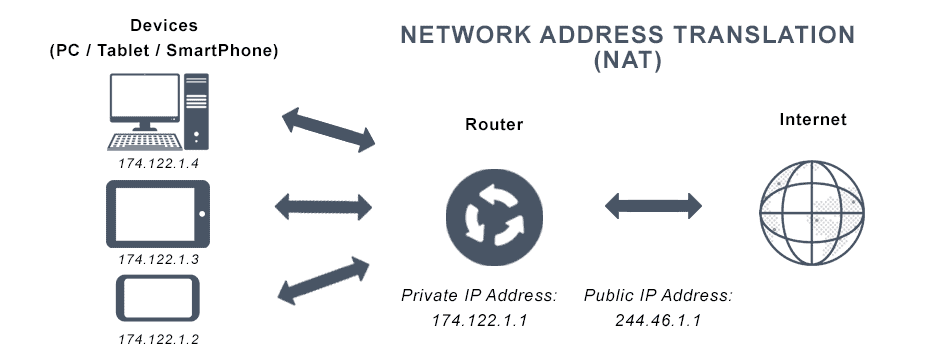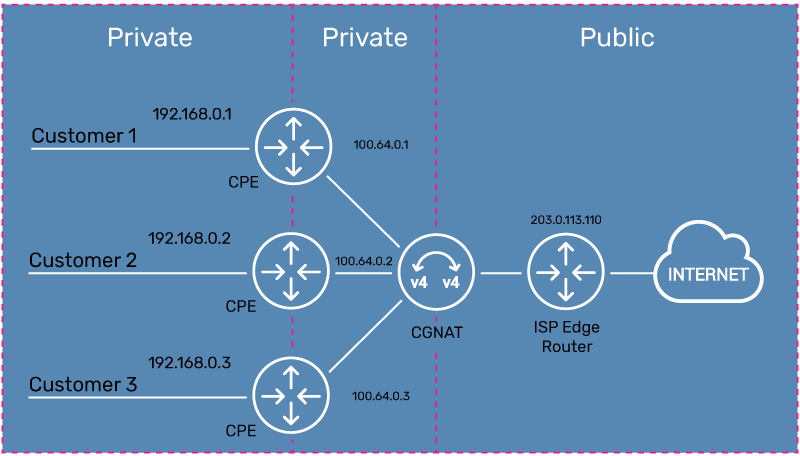Carrier-grade NAT (CGNAT)
The world is slowly but surely running out of IPv4 addresses – but the successor, IPv6, has not yet been established everywhere. Network Address Translation (NAT) and Carrier-Grade Network Address Translation (CGNAT) were therefore developed as methods for conserving IPv4 addresses. Although CGNAT is relatively widespread, the method has some disadvantages for end users. Anyone who wants to do more than just surf the Internet will soon reach the limits of CGNAT Internet access.
What is an IP address?
Each device connected to the Internet has its own IP address. This ensures that data packets reach the right recipient. Your IP address is effectively your postal address on the Internet.
However, your devices do not always have the same IP address. Depending on your Internet provider, you will be assigned new IP addresses at regular intervals or if you disconnect your router from the power supply for a certain period of time.
If you are dependent on a fixed IP address (e.g. because you operate your own server), you can obtain this from most Internet providers for an additional charge.
The Internet Assigned Numbers Authority (IANA) is responsible for the global pool of IP addresses. It coordinates the allocation of addresses to the Internet service providers. As IPv4 addresses are scarce, they are now also traded on specialised online platforms.
There are currently IPv4 and IPv6 addresses. The two types differ in the underlying address space.
IPv6 to replace IPv4 over time
IPv4 addresses have been around since the 1980s. The IPv4 address space comprises 32 bits, which corresponds to 232 or over 4 billion different IPv4 addresses. When IPv4 was developed, no one could have imagined that more than 4 billion addresses would ever be needed, but by the 1990s, an IPv4 shortage was already becoming apparent.
IPv6 was developed for this reason. IPv6 comprises 128 bits, which corresponds to 2128 or around 340 sextillion (one sextillion has 36 zeros) different IP addresses. IPv6 is intended to replace IPv4 over time.
Most modern devices now support IPv6. However, there are still a large number of services that can only be accessed via IPv4. And since IPv6 is not compatible with previous versions, both protocols will be used at the same time until the migration is finally complete. For example, statistics on the introduction of IPv6 can be found here.
Save IPv4 addresses with Network Address Translation (NAT)
In the meantime, efforts are being made to conserve IPv4 addresses. Network Address Translation (NAT) was developed for this reason. With NAT, several devices use the same IPv4 address. In detail, it works like this:
IPv4 addresses are divided into public and private addresses.
The public address is the address you use to access other networks from your private network, i.e. the address you use to surf the Internet. The public IPv4 address must be unique and unambiguous so that data traffic can be guaranteed. All devices connected to the same router use the same public IPv4 address.
All devices connected to the Internet have their own private IPv4 address within your private network. This only needs to be unique within your private network so that your router can forward the data packets to the correct terminal device. This means that your neighbour can use the same private IPv4 addresses as you in their private network.
The router performs the NAT function, i.e. it “translates” the private addresses into the public address and vice versa.
With IPv6, the need for shared addresses disappears, as there are enough IPv6 addresses for every terminal device. The NAT function is therefore not required with IPv6.

Conserve even more IPv4 addresses with Carrier-Grade NAT (CGNAT)
Some Internet providers do not have enough IPv4 addresses to provide each customer with an individual public IPv4 address. To avoid this problem, they are switching to Carrier-Grade NAT (CGNAT).
CGNAT functions according to the same principle as NAT, but at the provider level: The private IPv4 addresses of several customers are translated into one public IPv4 address. Several customers share the same public IPv4 address. The private IPv4 addresses of the terminal devices are translated twice: firstly, into one private IPv4 address per customer and then into the public IPv4 address for several customers.
An NAT router specifically responsible for translation ensures that the data packets reach the right customer.

With CGNAT, the end user is at a disadvantage
Although CGNAT has the advantage that IPv4 addresses can be conserved, the procedure has some disadvantages for the end user.
One such drawback is that it breaches the so-called end-to-end principle, as the data packets no longer flow directly from the sender’s IP address to the recipient’s IP address (this principle is already breached with NAT). Also, the end user does not receive its own public IP address. This means, for example, that it is not possible to offer one’s own service accessible under an IPv4 address or to operate one’s own server or VPN gateway. So anyone who wants to do more than just surf the Internet will quickly encounter limitations with CGNAT.
Init7 is also affected by the IPv4 shortage
Even Init7 does not have unlimited IPv4 addresses and has purchased IPv4 address blocks on the secondary market several times in the past. However, the price of IPv4 addresses has risen dramatically in recent years. While average prices per address were still between USD 6 and USD 24 in 2014, they were USD 23 to USD 60 in 2021 (read more here).
Init7 offers CGNAT service for private customers with Easy7
Easy7 is the new, more affordable alternative to Init7’s best-selling Fiber7. The service is based on IPv6 and CGNAT and is supplied with a fully automatically pre-configured FRITZ!Box 5530. Easy7 is suitable for anyone who does not require fixed IPv4 addresses or a free choice of routers. More information is available at https://www.init7.net/en/internet/easy7
